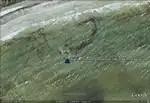During the scuttling of the German High Seas Fleet in Scapa Flow on 21 June 1919, not all of the ships were successfully sunk. One of these, the destroyer B98, was subsequently towed away but as she was passing Sanday, the tow line broke and she ran aground in the Bay of Lopness. Today, her turbines and boilers are still clearly visible from the beach at low tide.
Arguably the first true German destroyers, the eight vessels of this class had a peculiar origin. Turbine propulsion plants had been built by Blohm & Voss of Hamburg for a new class of destroyers for Russia, larger vessels than currently in German service. The outbreak of war in 1914 left two turbine plants and design material in German hands, and the yard proposed building destroyers around them, similar to the design developed for Russia. The first two vessels, B.98 and B.99, were completed in just half a year, and proved to be very capable vessels, so six more of the class were ordered and built by Blohm & Voss (B.109-112) and Vulcan (Stettin) (V.99/100). V.99 was lost to enemy action on 17 August, 1915. All the remaining vessels fought at Jutland and other engagements, and were later interned with the High Seas Fleet at Scapa Flow. When the scuttling order came on 21 June, 1919, B.109-112 were sunk, later raised and scrapped. B.98 was beached and had to be broken up, V.100 could not be scuttled and was ceded to France to be broken up in 1921, B.97 was ceded to Italy and served there until 1939. All in all, the type proved to be a successful design and led the way to more powerful destroyers. The main armament of 88 mm guns was found to be insufficient and replaced with 105 mm guns in 1916.

